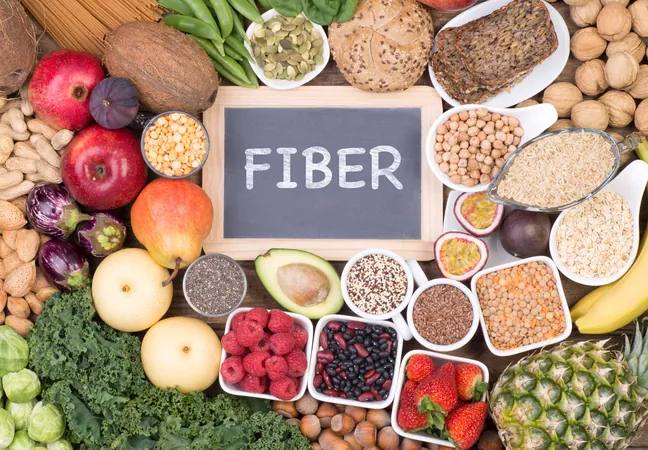
Rising Rates of Colorectal Cancer in Young Adults: What Pediatricians Can Do Now
2025-08-28
Author: Jia
A Wake-Up Call on Colorectal Cancer
Colorectal cancer was once thought to mainly affect the aging population. However, the landscape is shifting dramatically. By 2030, early-onset colorectal cancer (EOCRC)—affecting those under 50—could represent a staggering 11% of colon cancers and 24% of rectal cancers. Shocking predictions show a possible 90% increase in cases among 20- to 34-year-olds, highlighting the urgency to confront this emerging health crisis.
The Diet Dilemma: Are Childhood Choices to Blame?
While some EOCRC cases are linked to hereditary factors, the majority are not. The dietary habits established in childhood could be significantly contributing to the rise of this disease. Pediatricians, often the first healthcare providers that children encounter, have an essential role in shaping healthy eating habits that can last a lifetime.
The Alarming Statistics
The increasing rates of childhood obesity, poor dietary choices, and sedentary lifestyles are alarming factors potentially driving EOCRC’s rise. Excess weight in adolescents can lead to a slew of health problems, including chronic inflammation and insulin resistance—both of which can heighten cancer risks. A typical Western diet, filled with red meats, sugars, and ultraprocessed foods, might be putting our youth at greater risk. Reports indicate that diets high in fats nearly double the likelihood of developing EOCRC, and frequent fast food consumption correlates with a staggering tenfold increase in risk.
Fiber: The Missing Ingredient for Health
Despite the importance of fiber for long-term colon health, it is alarmingly under-consumed. A 2017 analysis revealed that a whopping 95% of Americans, children included, fail to meet the recommended intake. For example, toddlers average only 7-9 grams and preschoolers just 10-11.5 grams of fiber—far below the necessary amounts.
How Fiber Fights Cancer
Fiber plays a crucial role in maintaining gut health. It can be categorized into soluble (found in oats, beans, and fruits) and insoluble (found in whole grains and fibrous vegetables) fibers. Soluble fiber ferments in the gut, producing beneficial short-chain fatty acids, while insoluble fiber adds bulk to promote bowel regularity. Research shows that people consuming more whole grains exhibit a 16% lower risk of developing colorectal cancer.
Foods That Fight Back Against Cancer
It's not just about cutting back; it's equally vital to increase the intake of protective foods. Whole fruits, vegetables, legumes, and nuts are packed with anti-inflammatory and antioxidant properties that can help stave off cancer. These foods are essential in nurturing the body and may significantly lower cancer risk.
Simple Strategies for Parents
Translating fiber intake recommendations into everyday eating can be overwhelming, but it doesn’t have to be! Here are five fiber-rich foods that kids generally love: 1. **Popcorn** (2g per 3 cups): A fun snack that counts as whole grain. 2. **Raspberries** (4g per ½ cup): A fruity delight with extra fiber. 3. **Pears** (5.5g): Sweet and juicy, especially with the skin on. 4. **Green Peas** (4g per ½ cup): Easy to add to meals. 5. **Spinach** (4g per cup cooked): Tasty in smoothies or sauces.
The Pediatrician’s Critical Role
The fight against EOCRC begins with pediatricians. By addressing rising obesity rates and promoting healthier diets, they can intervene before kids reach screening age. Simple questions during visits can help shed light on a child’s eating habits: - "What does a typical day of eating look like for [child’s name]?" - "What are your favorite fruits and vegetables?" - "Do you poop every day? What does it look like?" - "What drinks do you enjoy?" Identifying small changes—like swapping one sugary drink for water—can lay the groundwork for healthy habits that last a lifetime. Pediatricians have the power to change the narrative surrounding colorectal cancer, one conversation at a time. Preventing EOCRC should not start at age 45 in a specialist’s office; it begins early in the pediatrician’s office, where proactive measures can make a significant impact.




 Brasil (PT)
Brasil (PT)
 Canada (EN)
Canada (EN)
 Chile (ES)
Chile (ES)
 Česko (CS)
Česko (CS)
 대한민국 (KO)
대한민국 (KO)
 España (ES)
España (ES)
 France (FR)
France (FR)
 Hong Kong (EN)
Hong Kong (EN)
 Italia (IT)
Italia (IT)
 日本 (JA)
日本 (JA)
 Magyarország (HU)
Magyarország (HU)
 Norge (NO)
Norge (NO)
 Polska (PL)
Polska (PL)
 Schweiz (DE)
Schweiz (DE)
 Singapore (EN)
Singapore (EN)
 Sverige (SV)
Sverige (SV)
 Suomi (FI)
Suomi (FI)
 Türkiye (TR)
Türkiye (TR)
 الإمارات العربية المتحدة (AR)
الإمارات العربية المتحدة (AR)